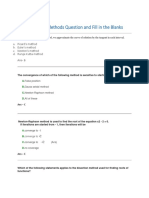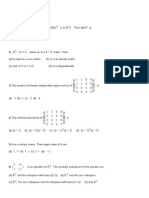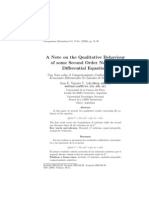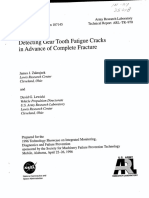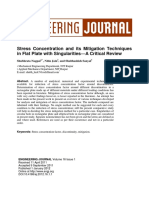Numerical Methods
Uploaded by
Rohit GadekarNumerical Methods
Uploaded by
Rohit GadekarISSN: 2319-8753
International Journal of Innovative Research in Science,
Engineering and Technology
(An ISO 3297: 2007 Certified Organization)
Vol. 2, Issue 10, October2013
NUMERICAL SOLUTION FOR BOUNDARY
VALUE PROBLEM
USING FINITE DIFFERENCE METHOD
R.LAKSHMI1, M.MUTHUSELVI2
Assistant Professor, Department of Mathematics, PSGR Krishnammal College for women, Coimbatore ,Tamil Nadu, India 1
Assistant Professor, Department of Mathematics, Dr.SNS Rajalakshmi College of Arts and Science, Coimbatore, Tamil Nadu,
India2
Abstract: In this paper, Numerical Methods for solving ordinary differential equations, beginning with basic techniques of
finite difference methods for linear boundary value problem is investigated. Numerical solution is found for the boundary
value problem using finite difference method and the results are compared with analytical solution. MATLAB coding is
developed for the finite difference method. The results are reported for conclusion.
KEYWORDS: Ordinary Differential Equations, finite Difference method, Boundary value problem, Analytical solution,
Numerical solution
I. INTRODUCTION
In mathematics, finite-difference methods are numerical methods for approximating the solutions to differential equations
using finite difference equations to approximate derivatives. Finite differences method is used in soil physics problems. An
important application of finite differences is in numerical analysis, especially in numerical differential equations, which aim at
the numerical solution of ordinary and partial differential equations respectively. The idea is to replace the derivatives
appearing in the differential equation by finite differences that approximate them. The resulting methods are called finite
difference methods. Common applications of the finite difference method are in computational science and engineering
disciplines, such as thermal engineering, fluid mechanics, etc.
A. STEPS INVOLVED IN FINITE DIFFERENCE METHOD
A finite difference method typically involves the following steps: Generate a grid, for example ( ; t (k)), where we want to
find an approximate solution.
Substitute the derivatives in a system of ordinary differential equations with finite difference schemes.
The ordinary differential equation then becomes a linear/non-linear system of algebraic equations.
Solve the system of algebraic equations. Implement and debug the computer code.
Do the error analysis, both analytically and numerically.
B. DERIVATION OF FINITE DIFFERENCE METHOD
Let consider the linear equations
x p(t ) x(t ) q(t ) x(t ) r (t )
(1)
With boundary condition x (a) = and x (b) = .
To start the derivation first replace each term x (tj) = xj
x j p j x j q j x j rj
Copyright to IJIRSET
(2)
www.ijirset.com
5305
ISSN: 2319-8753
International Journal of Innovative Research in Science,
Engineering and Technology
(An ISO 3297: 2007 Certified Organization)
Vol. 2, Issue 10, October2013
And the formula for central difference formula for first derivative
xj
Gives, substitute x (tj) = xj in the above equation, and get
x j 1 x j 1
2h
Now consider the second derivative of central difference formula equation
x(t j )
Substitute x (tj) = xj in equation (4) and get
xj
x(t j 1 ) 2 x(t j ) x(t j 1 )
h2
x j 1 2 x j x j 1
h2
o( h 2 )
(3)
o( h 2 )
(4)
o( h 2 )
(5)
Substitute equation (3) and (5) in (2) get,
x j 1 2 x j x j 1
x j 1 x j 1
o(h2 ) p(t j )(
o(h2 )) q(t j ) x j r (t j )
2
h
2h
Next, drop the two terms in o (h2) in equation (6)
x j 1 2 x j x j 1
h
o(h2 ) p(t j )(
x j 1 x j 1
2h
(6)
) q(t j ) x j r (t j )
(7)
And introduce the notation pj = p(tj), qj= q(tj) and rj = r(tj) in equation (7).
This produces the difference equation
x j 1 2 x j x j 1
x j 1 x j 1
(8)
pj (
) q j x j rj
2
h
2h
this is used to compute numerical approximation to the differential equation. This is carried out by multiplying each side of (8)
by h2, and then collecting terms involving xj-1, xj and xj+1 and arraying them in a system of linear equations.
(7) multiply by h2 gives
x j 1 2 x j x j 1
h
)h 2 h 2 [ p j (
x j 1 2 x j x j 1
equation (9) multiply by -1
x j 1 2 x j x j 1
Now collecting the term xj-1, xj and xj+1
x j 1 x j 1
2h
) q j x j rj ]
h
h
p j x j 1 p j x j 1 h2 q j x j h 2rj
2
2
(9)
h
h
p j x j 1 p j x j 1 h2 q j x j h2 rj
2
2
h
h
p j 1) x j 1 (2 h2 q j ) x j ( p j 1) x j 1 h 2 rj
2
2
(10)
h
h
p1 1) x0 (2 h 2 q1 ) x1 ( p1 1) x2 h 2 r1
2
2
(11)
h
h
p1 1) (2 h2 q1 ) x1 ( p1 1) x2 h 2 r1
2
2
for j = 1,2,N-1 in equation (10). when j = 1
And x0 = the equation (11) becomes
(2 h2 q1 ) x1 (
h
h
p1 1) x2 h 2 r1 ( p1 1)
2
2
(2 h 2 q1 ) x1 (
Copyright to IJIRSET
h
p1 1) x2 h 2 r1 eo
2
www.ijirset.com
(12)
5306
ISSN: 2319-8753
International Journal of Innovative Research in Science,
Engineering and Technology
(An ISO 3297: 2007 Certified Organization)
Vol. 2, Issue 10, October2013
where
e0 (
h
p1 1)
2
when j = N-1
h
h
( pN 1 1) xN 2 (2 h2 qN 1 ) xN 1 ( pN 1 1) xN h2 rN 1
2
2
And xN = , then the equation (13) becomes
h
h
( pN 1 1) xN 2 (2 h 2 qN 1 ) xN 1 h 2 rN 1 [ pN 1 1]
2
2
h
h
2
2
( pN 1 1) xN 2 (2 h qN 1 ) xN 1 h rN 1 [1 pN 1 ]
2
2
(
h2 rN 1 eN
h
pN 1 1) xN 2 (2 h 2 qN 1 ) xN 1 h 2 rN 1 eN
2
(13)
h
where eN [1
pN 1 ]
2
The system in equation (10), (12), (13) shows how the familiar triangle is formed, which is more visible when displayed with
matrix notations
2 h 2 q1
h
p1 1
2
h
h
p2 1
p2 1 2 h 2 q2
2
2
h
0
p3 1 2 h 2 q3
2
0
h
p j 1
2
where e0 (
...
...
...
...
h
p3 1
2
...
...
2 h 2 qJ
h
p j 1
2
...
h
pN 2 1 2 h 2 qN 2
2
x1
x
2
x3
x
j
xN 2
xN 1
h
pN 2 1
0
2
h
... pN 1 1 2 h 2 qN 1
2
h 2 r1 e0
h r2
h 2 r
h 2 r
h 2 rN 2
h rN 1 eN
(14)
h
h
pN 1 1)
p1 1) and eN (
2
2
0
...
II. FINITE DIFFERENCE METHOD FOR SOLVING BOUNDARY VALUE PROBLEM
2t
2
x(t )
x(t )
x(t ) 1 with x(0) = 1.25 and x(4) = -0.95 over the interval [0,4].
2
1 t
1 t2
A.
NUMERICAL SOLUTION FOR BOUNDARY VALUE PROBLEM
The given equation is
And consider the linear equation
Copyright to IJIRSET
x(t )
2t
2
x(t )
x(t ) 1
1 t2
1 t2
(15)
x j p j x j q j x j rj
www.ijirset.com
(16)
5307
ISSN: 2319-8753
International Journal of Innovative Research in Science,
Engineering and Technology
(An ISO 3297: 2007 Certified Organization)
Vol. 2, Issue 10, October2013
comparing equations (15) and (16) the values of pj , qj , rj are obtained. Approximation solution for boundary value problem
using finite difference method.
(
h
h
p j 1) x j 1 (2 h 2 q j ) x j ( p j 1) x j 1 h 2 rj
2
2
The finite-difference method is used to construct numerical solutions {x j} using the system of equations (10).There are 41
terms in the sequence generated with h 2 = 0.1, and the sequence {x j, 2 } only includes every other term from these
computations; they correspond to the 21 values of {t j} given in Table 1. Similarly, the sequences {x j.3 } and {xj, 4 } are a
portion of the values generated with step sizes h 3 = 0.05 and h 4 = 0.025, respectively, and they correspond to the 21 values
of {t j } in Table 1.
B. ANALYTIC (OR) EXACT SOLUTION FOR THE BOUNDARY VALUE PROBLEM
Next compare numerical solutions in Table 1 with the analytic solution. Let consider the equation (15), integrating twice
with respect to t to the limit 0 to 4 .
x(t)= 1.25+0.486089652t 2.25t2+2tarctan(t) ln (1+t2) +t 2ln (1+t)
(17)
Put t=0 ,x(0)=1.25000. Continuing this process the values are presented in the below table. Comparing the values of x (t), in
Table 1 and Table 2. The numerical solutions have error of order o (h2).
C. ERRORS IN NUMERICAL APPROXIMATION USING FINITE DIFFERENCE METHOD
results in the error being reduced by about . For instance, at tj = 1.0 the errors
Hence reducing the step size by a factor of
incurred with step sizes h1=0.2, h2 =0.1, h3 =0.05, and h4 =0.025 are
ej.1 = x(tj) xj,1 = 1.056886 - 1.042106 = 0.014780, e j.1 = 0.014780
e j,2 = x(tj) exact xj,2 = 1.056886 - 1.053226 =0.003660, e j,2 = 0.003660
e j,3 = x(tj) xj,3 = 1.056886 - 1.055973 = 0.000913, e j,3 = 0.000913 and
e j,4 = x(tj) xj,4 = 1.056886 - 1.056658 = 0.000228, e j,4 = 0.000228
Their successive ratios
are approaching
and
.
. A careful scrutiny of Table 3 will reveal that this is happening. And FIGURE-I shows that the
difference between the numerical approximation solution and analytic solution.
D. RICHARDSONS IMPROVEMENT SCHEME
Richardsons improvement scheme can be used to extrapolate the seemingly inaccurate sequences {xj,1}, {x j,2}, {xj,3}, and
{xj,4} and obtain six digits of precision. Eliminate the error terms o(h2) and o((h/2)2) in the approximations {x j,1} and {xj,2} by
generating the extrapolated sequence
{zj,1} = {(4xj,2 xj,1) / 3}.
(18)
Similarly, the error terms o((h/2)2) and o((h/4)2) for {xj,2} and {xj,3} are eliminated by generating
{zj,2} = {(4xj,3 xj,2) / 3}
(19)
It has been shown that the second level of Richardsons improvement scheme applies to the sequences {zj,1} and {zj,2} so the
third improvement is
= {(16z j,2 z j,1) / 15}
(20)
Now illustrate the situation by finding the extrapolated values that correspond to
= 1.0. The first extrapolated value is
(21)
The second extrapolated value is
Copyright to IJIRSET
www.ijirset.com
5308
ISSN: 2319-8753
International Journal of Innovative Research in Science,
Engineering and Technology
(An ISO 3297: 2007 Certified Organization)
Vol. 2, Issue 10, October2013
(22)
Finally, the third extrapolation involves the terms zj,1 and z j,2 :
(23)
This last computation contains six decimal places of accuracy. The values at the other points are given in Table 4.
E. MATLAB PROGRAM FOR FINITE DIFFERENCE METHOD USING SCRIPT FILE
clc;
% problem definition
aa=0;
bb=4;
n=20;
alpha=1.25;beta=-0.95;
h=(bb-aa)/n;
t=zeros(1,n+1);
x=zeros(1,n-1);
a=zeros(1,n-2);
b=zeros(1,n-1);
c=zeros(1,n-2);
d=zeros(1,n-1);
t=aa+h:h:aa+h*(n-1);
p=(2*t/(1+t.^2)).*ones(1,n-1);
q=(-2/(1+t.^2)).*ones(1,n-1);
r=1*ones(1,n-1);
% end problem definition
x=linspace(aa+h,bb,n);
a=zeros(1,n-1);
a(1:n-2)=-1-p(1,1:n-2)*h2;
d=(2+hh*q);
b=zeros(1,n-1);
b(2:n-1)=-1+p(1,2:n-1)*h2;
c(1)=hh*r(1)+(1+p(1)*h2)*alpha;
c(2:n-2)=-hh*r(2:n-2);
c(n-1)=hh*r(n-1)+(1-p(n-1)*h2)*beta;
x=trimat(a,d,b,c);
tt=[aa t bb];
xx=[alpha x beta];
out=[tt' xx'];
disp(out)plot(tt,xx)
grid on
F. MATLAB program for solving Tridiagonal systems using function file program
function x=trimat(A,D,C,B)
%Input- A is the sub diagonal of the co-efficient matrix
%
- D is the main diagonal of the co-efficient matrix
Copyright to IJIRSET
www.ijirset.com
5309
ISSN: 2319-8753
International Journal of Innovative Research in Science,
Engineering and Technology
(An ISO 3297: 2007 Certified Organization)
Vol. 2, Issue 10, October2013
%
- C is the super diagonal of the co-efficient matrix
%
- B is the constant vector of the linear system
%Output- x is the solution vector
N=length(B);
for k=2:N
mult=A(k-1)/D(k-1)
D(k)=D(k)-mult*C(k-1);
B(k)=B(k)-mult*B(k-1);
end
x(N)=B(N)/D(N);
for k=N-1:-1:1
x(k)=(B(k)-C(k)*x(k+1))/D(k);
end
TABLE I
NUMERICAL APPROXIMATION FOR
x(t )
2t
2
x(t )
x(t ) 1
1 t2
1 t2
0.0
xj,1
h1=0.2
1.250000
xj,2
h2=0.1
1.250000
xj,3
h3=0.05
1.250000
xj,4
h4=0.025
1.250000
0.2
1.314503
1.316640
1.317174
1.317306
0.4
1.320607
1.325045
1.326141
1.326414
0.6
1.272755
1.279533
1.281206
1.281623
0.8
1.177399
1.1896438
1.188670
1.189227
1.0
1.042106
1.053226
1.055973
1.056658
1.2
0.874878
0.887823
0.891023
0.891821
1.4
0.683712
0.698181
0.701758
0.702650
1.6
0.476372
0.494027
0.495900
0.496865
1.8
0.260264
0.276749
0.280828
0.281846
2.0
0.042399
0.059343
0.063537
0.064583
2.2
-0.170616
-0.153592
-0.149378
-0.148327
2.4
-0.372557
-0.355841
-0.351702
-0.350669
2.6
-0.557565
-0.541546
-0.537580
-0.536590
2.8
-0.720114
-0.705188
-0.701492
-0.700570
3.0
-0.854988
-0.841551
-0.838223
-0.837393
3.2
-0.957250
-0.945700
-0.942839
-0.942145
3.4
-1.022221
-1.012958
-1.010662
-1.010090
3.6
-1.045457
-1.038880
-1.37250
-1.086844
3.8
-1.022727
-1.019238
-1.018373
-1.018158
4.0
-0.950000
-0.950000
-0.950000
-0.950000
tj
Copyright to IJIRSET
www.ijirset.com
5310
ISSN: 2319-8753
International Journal of Innovative Research in Science,
Engineering and Technology
(An ISO 3297: 2007 Certified Organization)
Vol. 2, Issue 10, October2013
TABLE II
EXACT SOLUTION FOR THE GIVEN BOUNDARY VALUE PROBLEM
tj
0.0
0.2
0.4
0.6
0.8
1.0
1.2
1.4
1.6
1.8
2.0
2.2
2.4
2.6
2.8
3.0
3.2
3.4
3.6
3.8
4.0
x (tj)
1.2500
1.317350
1.326505
1.28762
1.189412
1.056886
0.892086
0.702947
0.497187
0.282184
0.064931
-0.147977
-0.350325
-0.536261
-0.700262
-0.837116
-0.941888
-1.009899
-1.036709
-1.018086
-0.950000
TABLE III
ERRORS IN NUMERICAL APPROXIMATIONS USING THE FINITE-DIFFERENCE METHOD
tj
x (tj ) xj,1 =ej,1
x (tj) xj,2 =ej,2
0.0
0.2
0.4
0.6
0.8
1.0
1.2
1.4
1.6
1.8
2.0
h 1 =0.2
0.000000
0.002847
0.005898
0.009007
0.012013
0.014780
0.017208
0.019235
0.020815
0.021920
0.022533
h 2 = 0.1
0.000000
0.000704
0.001460
0.002229
0.002974
0.003660
0.004263
0.004766
0.005160
0.005435
0.005588
Copyright to IJIRSET
x (t j ) xj,3 = ej,3
h 3 = 0.05
0.000000
0.000176
0.000364
0.000556
0.000742
0.000913
0.001063
0.001189
0.001287
0.001356
0.001394
www.ijirset.com
x (t j ) xj,4=ej,4
h 4 =0.025
0.000000
0.000044
0.000091
0.000139
0.000185
0.000228
0.000265
0.000297
0.000322
0.000338
0.000348
5311
ISSN: 2319-8753
International Journal of Innovative Research in Science,
Engineering and Technology
(An ISO 3297: 2007 Certified Organization)
Vol. 2, Issue 10, October2013
2.2
2.4
2.6
2.8
3.0
3.2
3.4
3.6
3.8
4.0
0.022639
0.022232
0.021304
0.019852
0.017872
0.015362
0.012322
0.008749
0.004641
0.000000
0.005615
0.001401
0.000350
0.005516
0.001377
0.000344
0.005285
0.001319
0.000329
0.004926
0.001230
0.000308
0.004435
0.001107
0.000277
0.003812
0.000951
0.000237
0.003059
0.000763
0.000191
0.002171
0.000541
0.000135
0.001152
0.000287
0.000072
0.000000
0.000000
0.000000
TABLE IV
EXTRAPOLATION OF THE NUMERICAL APPLICATIONS {XJ,1 }, {XJ,2 },{XJ,3 }
OBTAINED WITH THE FINITE DIFFERENCE METHOD.
tj
0.0
0.2
0.4
0.6
0.8
1.0
1.2
1.4
1.6
1.8
2.0
2.2
2.4
2.6
2.8
3.0
3.2
3.4
3.6
3.8
4.0
0.0
Copyright to IJIRSET
1.250000
1.317360
1.326524
1.281792
1.189451
1.056932
0.892138
0.703003
0.497246
0.282244
0.064991
0.147918
0.350268
0.536207
0.700213
0.837072
0.941850
1.009870
1.036688
1.018075
0.950000
1.250000
1.250000
1.317351
1.326506
1.281764
1.189414
1.056889
0.892090
0.702951
0.497191
0.282188
0.064935
0.147973
0.350322
0.536258
0.700259
0.837113
0.941885
1.009898
1.036707
1.018085
0.950000
1.250000
1.250000
1.317350
1.326504
1.281762
1.189412
1.056886
0.892086
0.702947
0.497187
0.282184
0.064931
0.147977
0.350325
0.536261
0.700263
0.837116
0.941888
1.009899
1.036708
1.018086
0.950000
1.250000
www.ijirset.com
x (t j )
Exact solution
1.250000
1.317350
1.326505
1.281762
1.189412
1.056886
0.892086
0.702948
0.497187
0.282184
0.064931
0.147977
0.350325
0.536261
0.700262
0.837116
0.941888
1.009899
1.036708
1.018086
0.950000
1.250000
5312
ISSN: 2319-8753
International Journal of Innovative Research in Science,
Engineering and Technology
(An ISO 3297: 2007 Certified Organization)
Vol. 2, Issue 10, October2013
1.5
x(t)
0.5
-0.5
-1
-1.5
0.5
1.5
2
t
2.5
3.5
Numerical approximation solution
Exact solution
Fig. I Comparing the solution of numerical approximation solution, exact solution and solution of the finite difference method
using MATLAB program to the given boundary value problem
III. CONCLUSION
A boundary value problem is solved using finite difference method and is verified with exact solution. It is found that the
results are agreed with exact solution.
REFERENCES
[1].John H.Mathews , Kurtis D. Fink, Numerical Methods Using MATLAB, Fourth Edition,2008, Published by Dorling Kindersley(INDIA)Pvt.Ltd., New
Delhi.
[2].DR. M. K. Venkataraman, Numerical Methods in Science And Engineering, Fifth Edition (Revised & Enlarged ), 2004, The National Publishing co.,
Chennai.
[3].H. C. Saxena, Finite-Differences and Numerical Analysis, Thirteen Revised Edition, 1997, Published by S. Chand& Company Ltd., New Delhi.
[4].Laurence V. Fausett, Applied Numerical Analysis Using MATLAB, Second Edition, 2009, Published by Dorling Kindersley(INDIA)Pvt.Ltd., Noida.
[5 ].http://www.mathwork.com/matlab/fd/method.
Copyright to IJIRSET
www.ijirset.com
5313
You might also like
- AHA ACLS Precourse Self Assessment Answers 202392% (24)AHA ACLS Precourse Self Assessment Answers 202332 pages
- USMLE World Step 3 High Yield Notes 90 Pages95% (58)USMLE World Step 3 High Yield Notes 90 Pages90 pages
- The Manual of Free Energy Devices and Systems (1991)93% (208)The Manual of Free Energy Devices and Systems (1991)128 pages
- Seventy-Eight Degrees of Wisdom - A Book of Tarot, Revised - Rachel Pollack100% (40)Seventy-Eight Degrees of Wisdom - A Book of Tarot, Revised - Rachel Pollack370 pages
- Joe Tippens' Protocol and Scientific Backing PDF86% (7)Joe Tippens' Protocol and Scientific Backing PDF2 pages
- Bessel Van Der Kolk - The Body Keeps The Score - Brain, Mind, and Body in The Healing of Trauma-Penguin (2014)100% (11)Bessel Van Der Kolk - The Body Keeps The Score - Brain, Mind, and Body in The Healing of Trauma-Penguin (2014)490 pages
- Kiss Your Dentist Goodbye A Do It Yourself Mouth Care System For Healthy - Clean Gums and Teeth by El100% (13)Kiss Your Dentist Goodbye A Do It Yourself Mouth Care System For Healthy - Clean Gums and Teeth by El210 pages
- Mark Sloan, Ray Peat, Raymond Peat - The Ultimate Guide to Methylene Blue_ Remarkable Hope for Depression, COVID, AIDS & Other Viruses, Alzheimer’s, Autism, Cancer, Heart Disease, ... Targeting Mitoch100% (14)Mark Sloan, Ray Peat, Raymond Peat - The Ultimate Guide to Methylene Blue_ Remarkable Hope for Depression, COVID, AIDS & Other Viruses, Alzheimer’s, Autism, Cancer, Heart Disease, ... Targeting Mitoch171 pages
- Circumcision Photo Guide: What To Expect After Surgery: Patient and Family Education18% (11)Circumcision Photo Guide: What To Expect After Surgery: Patient and Family Education2 pages
- Cognitive Therapy Therapy Techniques For Retraining Your Brain - Jason M. Satterfield97% (71)Cognitive Therapy Therapy Techniques For Retraining Your Brain - Jason M. Satterfield222 pages
- 5.chapter-5 Numerical Methods QuestionsNo ratings yet5.chapter-5 Numerical Methods Questions30 pages
- Multiple-Choice Test Newton's Divided Difference Polynomial Method InterpolationNo ratings yetMultiple-Choice Test Newton's Divided Difference Polynomial Method Interpolation7 pages
- Multiple Choice Questions - 1st Online Test: Numerical MethodsNo ratings yetMultiple Choice Questions - 1st Online Test: Numerical Methods3 pages
- Unit - IV: Numerical Solutions of Differential Equations (MCQ)No ratings yetUnit - IV: Numerical Solutions of Differential Equations (MCQ)5 pages
- Multiple Choice Question of Computational GeometryNo ratings yetMultiple Choice Question of Computational Geometry9 pages
- Multiple-Choice Test False-Position Method of Solving A Nonlinear EquationNo ratings yetMultiple-Choice Test False-Position Method of Solving A Nonlinear Equation4 pages
- Newton Raphson Method For Non-Linear EquationsNo ratings yetNewton Raphson Method For Non-Linear Equations2 pages
- Sheetal 202890 PPT Integral Equation and Calculus of VariationsNo ratings yetSheetal 202890 PPT Integral Equation and Calculus of Variations13 pages
- Conjugate Harmonic Function Harmonic Conjugate Function: Milne - Thomson's Method100% (2)Conjugate Harmonic Function Harmonic Conjugate Function: Milne - Thomson's Method5 pages
- Assignment-3 - Limit, Continuity and DifferentiationNo ratings yetAssignment-3 - Limit, Continuity and Differentiation1 page
- Chapter 02 (Solution of Algebraic & Transcendental Equation)100% (1)Chapter 02 (Solution of Algebraic & Transcendental Equation)24 pages
- 250+ TOP MCQs On Laplace Transform - 1 and AnswersNo ratings yet250+ TOP MCQs On Laplace Transform - 1 and Answers7 pages
- Partial Differential Equations Question Bank100% (3)Partial Differential Equations Question Bank12 pages
- Differential Equations Previous Years Questions100% (1)Differential Equations Previous Years Questions14 pages
- Errors Analysis and Basic Definitions in Numerical AnalysisNo ratings yetErrors Analysis and Basic Definitions in Numerical Analysis14 pages
- Appendix Multiple Choice Questions (MCQ'S) Ch. 1 Linear Differential Equations With Constant CoefficientNo ratings yetAppendix Multiple Choice Questions (MCQ'S) Ch. 1 Linear Differential Equations With Constant Coefficient80 pages
- Shannon Wavelet Regularization Methods For A Backward Heat EquationNo ratings yetShannon Wavelet Regularization Methods For A Backward Heat Equation7 pages
- Gear Crack Propagation Investigations: Iqgo LaloNo ratings yetGear Crack Propagation Investigations: Iqgo Lalo16 pages
- Detecting Gear Tooth Fatigue Cracks in Advance of Complete FractureNo ratings yetDetecting Gear Tooth Fatigue Cracks in Advance of Complete Fracture18 pages
- A Unified Curvature Theory in Kinematic Mechanism PDFNo ratings yetA Unified Curvature Theory in Kinematic Mechanism PDF7 pages
- What Parents and Teachers Should Know About Adhd: Center For Children and FamiliesNo ratings yetWhat Parents and Teachers Should Know About Adhd: Center For Children and Families2 pages
- Pharmacology Cheat Sheet - Generic Drug Stems - Nurseslabs100% (1)Pharmacology Cheat Sheet - Generic Drug Stems - Nurseslabs12 pages
- Take Back Your Life Now - Powerful Guide For Recovering From Narcissistic AbuseNo ratings yetTake Back Your Life Now - Powerful Guide For Recovering From Narcissistic Abuse63 pages
- Project Looking Glass: QAnon Post 3094 Ir0nbelly93% (27)Project Looking Glass: QAnon Post 3094 Ir0nbelly89 pages
- The Manual of Free Energy Devices and Systems (1991)The Manual of Free Energy Devices and Systems (1991)
- Seventy-Eight Degrees of Wisdom - A Book of Tarot, Revised - Rachel PollackSeventy-Eight Degrees of Wisdom - A Book of Tarot, Revised - Rachel Pollack
- Bessel Van Der Kolk - The Body Keeps The Score - Brain, Mind, and Body in The Healing of Trauma-Penguin (2014)Bessel Van Der Kolk - The Body Keeps The Score - Brain, Mind, and Body in The Healing of Trauma-Penguin (2014)
- Kiss Your Dentist Goodbye A Do It Yourself Mouth Care System For Healthy - Clean Gums and Teeth by ElKiss Your Dentist Goodbye A Do It Yourself Mouth Care System For Healthy - Clean Gums and Teeth by El
- Mark Sloan, Ray Peat, Raymond Peat - The Ultimate Guide to Methylene Blue_ Remarkable Hope for Depression, COVID, AIDS & Other Viruses, Alzheimer’s, Autism, Cancer, Heart Disease, ... Targeting MitochMark Sloan, Ray Peat, Raymond Peat - The Ultimate Guide to Methylene Blue_ Remarkable Hope for Depression, COVID, AIDS & Other Viruses, Alzheimer’s, Autism, Cancer, Heart Disease, ... Targeting Mitoch
- Circumcision Photo Guide: What To Expect After Surgery: Patient and Family EducationCircumcision Photo Guide: What To Expect After Surgery: Patient and Family Education
- Cognitive Therapy Therapy Techniques For Retraining Your Brain - Jason M. SatterfieldCognitive Therapy Therapy Techniques For Retraining Your Brain - Jason M. Satterfield
- Multiple-Choice Test Newton's Divided Difference Polynomial Method InterpolationMultiple-Choice Test Newton's Divided Difference Polynomial Method Interpolation
- Multiple Choice Questions - 1st Online Test: Numerical MethodsMultiple Choice Questions - 1st Online Test: Numerical Methods
- Unit - IV: Numerical Solutions of Differential Equations (MCQ)Unit - IV: Numerical Solutions of Differential Equations (MCQ)
- Multiple Choice Question of Computational GeometryMultiple Choice Question of Computational Geometry
- Multiple-Choice Test False-Position Method of Solving A Nonlinear EquationMultiple-Choice Test False-Position Method of Solving A Nonlinear Equation
- Sheetal 202890 PPT Integral Equation and Calculus of VariationsSheetal 202890 PPT Integral Equation and Calculus of Variations
- Conjugate Harmonic Function Harmonic Conjugate Function: Milne - Thomson's MethodConjugate Harmonic Function Harmonic Conjugate Function: Milne - Thomson's Method
- Assignment-3 - Limit, Continuity and DifferentiationAssignment-3 - Limit, Continuity and Differentiation
- Chapter 02 (Solution of Algebraic & Transcendental Equation)Chapter 02 (Solution of Algebraic & Transcendental Equation)
- 250+ TOP MCQs On Laplace Transform - 1 and Answers250+ TOP MCQs On Laplace Transform - 1 and Answers
- Errors Analysis and Basic Definitions in Numerical AnalysisErrors Analysis and Basic Definitions in Numerical Analysis
- Appendix Multiple Choice Questions (MCQ'S) Ch. 1 Linear Differential Equations With Constant CoefficientAppendix Multiple Choice Questions (MCQ'S) Ch. 1 Linear Differential Equations With Constant Coefficient
- Shannon Wavelet Regularization Methods For A Backward Heat EquationShannon Wavelet Regularization Methods For A Backward Heat Equation
- Detecting Gear Tooth Fatigue Cracks in Advance of Complete FractureDetecting Gear Tooth Fatigue Cracks in Advance of Complete Fracture
- A Unified Curvature Theory in Kinematic Mechanism PDFA Unified Curvature Theory in Kinematic Mechanism PDF
- What Parents and Teachers Should Know About Adhd: Center For Children and FamiliesWhat Parents and Teachers Should Know About Adhd: Center For Children and Families
- Pharmacology Cheat Sheet - Generic Drug Stems - NurseslabsPharmacology Cheat Sheet - Generic Drug Stems - Nurseslabs
- Take Back Your Life Now - Powerful Guide For Recovering From Narcissistic AbuseTake Back Your Life Now - Powerful Guide For Recovering From Narcissistic Abuse

























